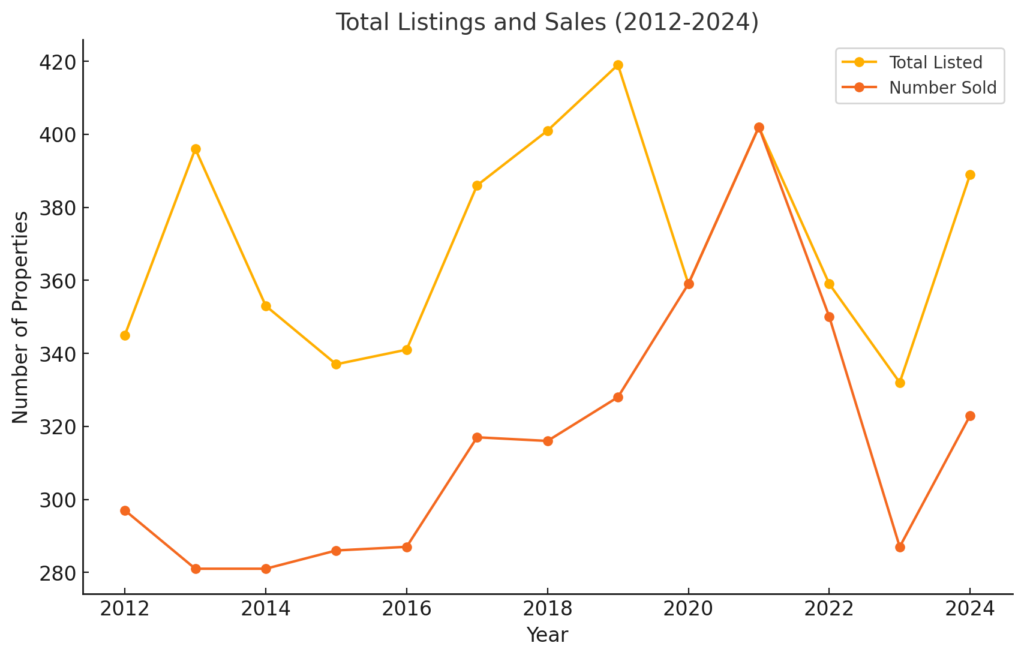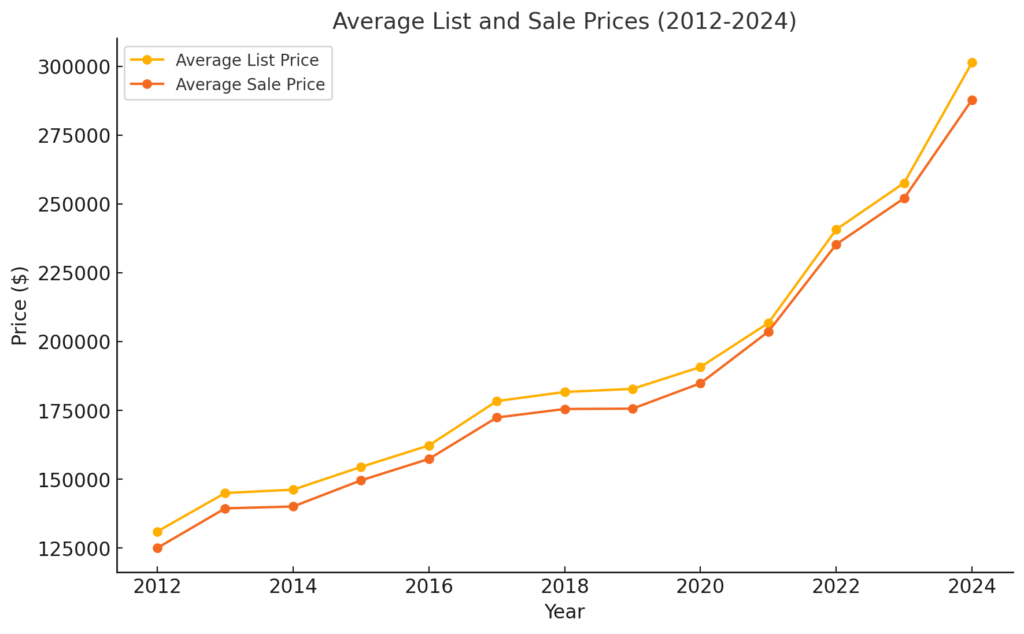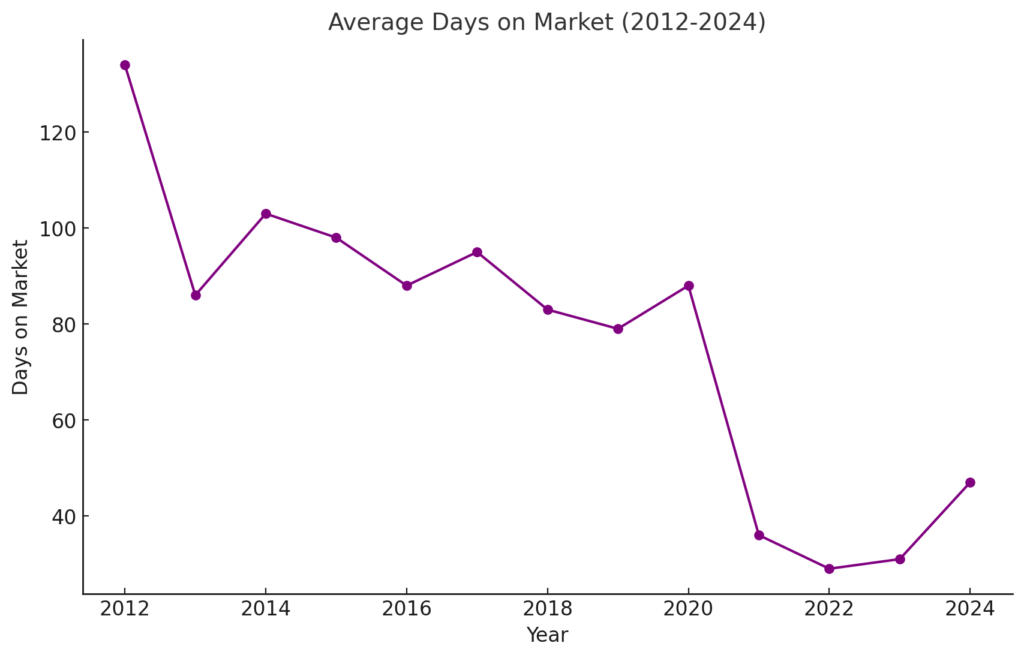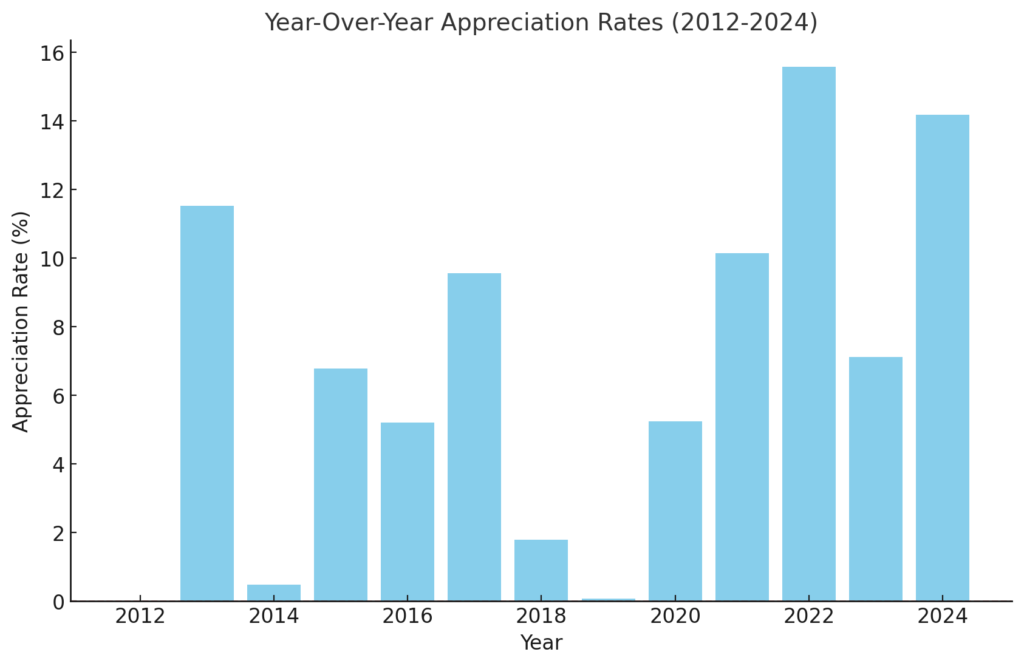Written by: Mason Schramm, Broker/Owner, The Move Group
The Meridian Association of Realtors MLS area, covering Southeast South Dakota and Northeast Nebraska, has long been a region where buyers and sellers find unique opportunities in the real estate market. In 2024, however, the market faced a challenging but fascinating year shaped by high interest rates, low inventory, and strong demand for residential properties. Despite the challenges, the market proved resilient, with significant trends that set the stage for an intriguing outlook in 2025.
Let’s take a deep dive into what defined the real estate landscape in 2024, how it compared to previous years, and what might be on the horizon as we look toward a potentially lower-rate environment in the year ahead.
2024 in Review: Key Market Highlights
The year 2024 was a study in contrasts. Elevated mortgage rates averaging 7% put a strain on affordability for many buyers. Despite this, home prices continued to rise, inventory remained constrained, and the market dynamics favored sellers willing to navigate longer selling timelines. Here’s what stood out:
Higher Prices Amid Higher Rates
Average list prices in 2024 surged to $301,364, a 17% increase over 2023. Sale prices followed closely, with an average of $287,826, marking a 14% year-over-year appreciation. This trend underscored the continued strength of demand, even in a challenging financial environment.
Buyers faced the dual pressure of limited inventory and higher borrowing costs, leading them to focus on properties that offered immediate value and move-in readiness. This willingness to pay a premium despite financial headwinds was a testament to the enduring attractiveness of the Meridian area.
Slower Transactions
The average days on market in 2024 climbed to 47, up from 31 days in 2023 and significantly higher than the record-low of 29 days in 2022. This increase reflected the growing caution among buyers who needed more time to assess affordability and navigate stricter loan conditions. Sellers, while still benefiting from price growth, had to exercise patience as transactions took longer to close.
Inventory Struggles Persist
Despite a 13% rise in new listings compared to 2023, the market remained in a state of low inventory. Only 389 properties were listed in 2024, well below the peak listing numbers seen earlier in the decade. The sell-through rate of 83%—while strong—was a step back from the 100% rates of 2020 and 2021, further illustrating the market’s gradual shift from the frenzied activity of the pandemic years.

How 2024 Stacks Up Against Previous Years
The 2024 real estate market wasn’t an anomaly—it was the latest chapter in a longer narrative of growth and evolution. Let’s see how it compared with the past decade:
Long-Term Price Growth
The Meridian area has seen incredible price appreciation over the years. From an average sale price of $125,011 in 2012, prices have grown more than 130%. This growth trend reflects a combination of increasing demand, regional economic stability, and constrained housing supply.
Interestingly, the 14% appreciation rate in 2024 was among the highest in recent years, second only to the 16% growth seen in 2022. Even during years of economic uncertainty and rising rates, the market continued its upward trajectory, solidifying the region’s reputation as a strong long-term investment.
Evolving Market Speed
A decade ago, it wasn’t uncommon for homes to stay on the market for 100 days or more. Fast forward to the present, and even the relatively slower 2024 pace of 47 days feels like a return to normalcy compared to the breakneck 29-36 days seen in 2021-2022.
The Interest Rate Factor
While 2024’s 7% interest rates created hurdles for buyers, the market’s ability to maintain high prices and steady activity reflects its resilience. By comparison, lower interest rates in the mid-2010s provided easier access to financing, fueling faster turnover and broader buyer participation.

Navigating the 2024 Market: Challenges and Opportunities
Low Inventory Keeps Sellers in Control
In 2024, the fundamental issue of low inventory continued to shape the market. Limited new construction and slow turnover of existing homes ensured that demand outpaced supply. For sellers, this meant the ability to set higher prices and retain negotiating leverage, even if it took longer to close deals.
Affordability Challenges for Buyers
With borrowing costs elevated, many buyers found themselves pushed to their financial limits. This was especially evident among first-time homebuyers, who faced the dual challenges of higher monthly payments and rising home prices. Those who succeeded often turned to properties requiring minimal renovation, reducing the financial strain of post-purchase improvements.
Resilient Demand in a Shifting Market
Despite these challenges, buyer interest remained strong. Families, investors, and individuals seeking long-term value saw the Meridian area as a worthwhile investment. As a result, even in the face of headwinds, the market demonstrated remarkable stability.

Looking Ahead to 2025: A Potential Game-Changer
What happens if interest rates trend lower in 2025? The possibilities could fundamentally shift the dynamics of this already competitive market.
A Surge in Buyer Activity
Lower rates would likely reignite demand among buyers who were priced out in 2024. More affordable financing could bring sidelined buyers back to the table, increasing competition for already scarce listings. For first-time buyers, lower rates might finally open doors that felt closed in 2024.
Upward Price Pressure
With demand rising faster than inventory, prices could see another significant jump. Home values in desirable neighborhoods or move-in-ready condition are especially likely to see bidding wars, potentially pushing prices into new territory.
Faster Market Cycles
As affordability improves, days on market are likely to shorten. Buyers, aware of heightened competition, may act quickly to secure their desired properties, creating a more dynamic and fast-paced marketplace.
Challenges for Builders
Even as demand rises, addressing the inventory issue won’t be easy. Builders face rising costs for materials and labor, limiting their ability to meet growing demand. While new construction could alleviate some pressure, it’s unlikely to fully resolve the imbalance.

Strategies for 2025 and Beyond
For Buyers
Be ready to act quickly. With competition set to intensify, financial preparation will be key. Work with lenders to secure pre-approvals and focus on properties with strong long-term value. Don’t wait for prices to stabilize—they likely won’t.
For Sellers
Maximize your property’s appeal with pre-listing improvements and strategic pricing. If rates fall, expect more buyers at your door, but don’t overprice in anticipation of competition; a fair price can still attract premium offers.
For Realtors
The year ahead will demand agility and foresight. Stay informed on rate changes, guide clients on navigating market complexities, and leverage technology to market properties effectively. Transparency and education will be critical in maintaining trust during periods of rapid change.


